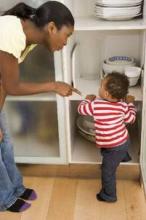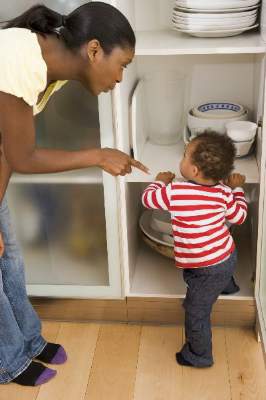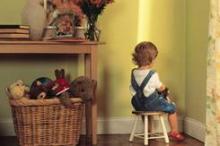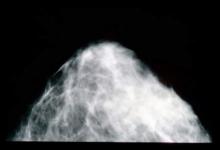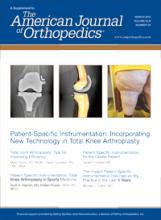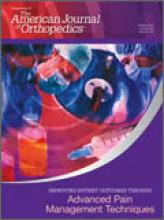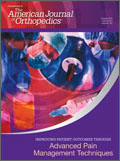User login
CDC Parenting Essentials: Discipline
As part of its “Essentials for Parenting Toddlers and Preschoolers” series, the Centers for Disease Control and Prevention has released some recommendations for parents on how to use discipline and consequences to address unwanted behavior in young children.
What happens immediately after a child’s behaviors – whether good or bad – can make the action more or less likely to occur in the future, according to the CDC. This is why appropriate consequences are so important.
While praise and other types of positive consequences may be used to reward desired behavior, parents should also know when to use different types of discipline, or negative consequences, when a child has misbehaved in some way.
The CDC suggests that following negative consequences be used to discipline bad behavior and make those behaviors less likely to happen again:
1. Ignoring. Taking attention away from a child who is whining or throwing a tantrum can decrease the likelihood of the behavior continuing. When using ignoring as a form of discipline, avoid all eye contact, conversation, and attempts to get your attention.
2. Distraction. Using distractions such as games and toys can stop unwanted behaviors by redirecting the child’s focus elsewhere.
3. Natural consequences. In some situations, the negative consequences that naturally occur as the result of a bad behavior may serve as punishment in itself. For instance, if a child repeatedly bangs a toy and it breaks, the child has learned from his or her mistakes by seeing the consequence firsthand. The only caveat to allowing natural consequences to happen is to be careful that this does not put the child in danger.
4. Delay of a privilege. This method may involve taking away toys that are not handled carefully or not allowing the child to play outside until they have cleaned up their toys. This teaches the child about logical consequences that are directly related to their actions.
5. Time-Out. This involves removing the child from anything that may be distracting or hold his or her attention.
To learn more about effective discipline, visit the CDC website. To view examples of how to use discipline with toddlers, watch the video “How to Use Discipline and Consequences.”
As part of its “Essentials for Parenting Toddlers and Preschoolers” series, the Centers for Disease Control and Prevention has released some recommendations for parents on how to use discipline and consequences to address unwanted behavior in young children.
What happens immediately after a child’s behaviors – whether good or bad – can make the action more or less likely to occur in the future, according to the CDC. This is why appropriate consequences are so important.
While praise and other types of positive consequences may be used to reward desired behavior, parents should also know when to use different types of discipline, or negative consequences, when a child has misbehaved in some way.
The CDC suggests that following negative consequences be used to discipline bad behavior and make those behaviors less likely to happen again:
1. Ignoring. Taking attention away from a child who is whining or throwing a tantrum can decrease the likelihood of the behavior continuing. When using ignoring as a form of discipline, avoid all eye contact, conversation, and attempts to get your attention.
2. Distraction. Using distractions such as games and toys can stop unwanted behaviors by redirecting the child’s focus elsewhere.
3. Natural consequences. In some situations, the negative consequences that naturally occur as the result of a bad behavior may serve as punishment in itself. For instance, if a child repeatedly bangs a toy and it breaks, the child has learned from his or her mistakes by seeing the consequence firsthand. The only caveat to allowing natural consequences to happen is to be careful that this does not put the child in danger.
4. Delay of a privilege. This method may involve taking away toys that are not handled carefully or not allowing the child to play outside until they have cleaned up their toys. This teaches the child about logical consequences that are directly related to their actions.
5. Time-Out. This involves removing the child from anything that may be distracting or hold his or her attention.
To learn more about effective discipline, visit the CDC website. To view examples of how to use discipline with toddlers, watch the video “How to Use Discipline and Consequences.”
As part of its “Essentials for Parenting Toddlers and Preschoolers” series, the Centers for Disease Control and Prevention has released some recommendations for parents on how to use discipline and consequences to address unwanted behavior in young children.
What happens immediately after a child’s behaviors – whether good or bad – can make the action more or less likely to occur in the future, according to the CDC. This is why appropriate consequences are so important.
While praise and other types of positive consequences may be used to reward desired behavior, parents should also know when to use different types of discipline, or negative consequences, when a child has misbehaved in some way.
The CDC suggests that following negative consequences be used to discipline bad behavior and make those behaviors less likely to happen again:
1. Ignoring. Taking attention away from a child who is whining or throwing a tantrum can decrease the likelihood of the behavior continuing. When using ignoring as a form of discipline, avoid all eye contact, conversation, and attempts to get your attention.
2. Distraction. Using distractions such as games and toys can stop unwanted behaviors by redirecting the child’s focus elsewhere.
3. Natural consequences. In some situations, the negative consequences that naturally occur as the result of a bad behavior may serve as punishment in itself. For instance, if a child repeatedly bangs a toy and it breaks, the child has learned from his or her mistakes by seeing the consequence firsthand. The only caveat to allowing natural consequences to happen is to be careful that this does not put the child in danger.
4. Delay of a privilege. This method may involve taking away toys that are not handled carefully or not allowing the child to play outside until they have cleaned up their toys. This teaches the child about logical consequences that are directly related to their actions.
5. Time-Out. This involves removing the child from anything that may be distracting or hold his or her attention.
To learn more about effective discipline, visit the CDC website. To view examples of how to use discipline with toddlers, watch the video “How to Use Discipline and Consequences.”
CDC Parenting Essentials: Time-Out
The last portion of the Centers for Disease Control and Prevention’s online resource, “Essentials for Parenting Toddlers and Preschoolers,” focuses on using time-out as a form of discipline, and offers guidance on how and when this method should be used with young children.
When used correctly, time-out can be very effective in stopping undesired behavior, because children dislike being bored, and time-out removes the child from all sources of fun, activity, and attention.
So when should a parent use time-out?
The CDC recommends using time-out in the following situations:
1. The child has done something dangerous, such as running in the street.
2. The child has done something harmful to another child, such as fighting or biting.
3. The child has broken a family rule.
4. The child continues the misbehavior after a warning.
A warning can be used the first time the child misbehaves, and the time-out may be carried out if the child continues the unwanted behavior. CDC offers the following steps parents can take when using time-out:
1. Give a warning. Let the child know what he has done wrong, and that if he does not stop, he or she will be put in a time-out.
2. Explain why. Calmly tell the child why they are in time-out. Do not argue, scold, or talk to your child when they are sitting in time out.
3. Administer the time-out. If the child repeatedly moves or leaves the time-out space, you may need to be persistent in putting him or her back in the time-out space. Limit your interaction as much as possible when doing this.
4. End time-out. A good rule of thumb is to have the child sit in time-out for 1 minute per year of his or her age. For instance, a 4-year-old would sit in time-out for 4 minutes. Make sure your child has been quiet for at least 5 seconds at the end of time-out, and remind them what behavior you expect.
5. Praise the next good behavior the child does. This gives him or her a chance to follow directions properly.
For more information on using time out, visit the CDC website. To view examples of how to use this form of discipline, watch the video “How to Use Time-Out.”
The last portion of the Centers for Disease Control and Prevention’s online resource, “Essentials for Parenting Toddlers and Preschoolers,” focuses on using time-out as a form of discipline, and offers guidance on how and when this method should be used with young children.
When used correctly, time-out can be very effective in stopping undesired behavior, because children dislike being bored, and time-out removes the child from all sources of fun, activity, and attention.
So when should a parent use time-out?
The CDC recommends using time-out in the following situations:
1. The child has done something dangerous, such as running in the street.
2. The child has done something harmful to another child, such as fighting or biting.
3. The child has broken a family rule.
4. The child continues the misbehavior after a warning.
A warning can be used the first time the child misbehaves, and the time-out may be carried out if the child continues the unwanted behavior. CDC offers the following steps parents can take when using time-out:
1. Give a warning. Let the child know what he has done wrong, and that if he does not stop, he or she will be put in a time-out.
2. Explain why. Calmly tell the child why they are in time-out. Do not argue, scold, or talk to your child when they are sitting in time out.
3. Administer the time-out. If the child repeatedly moves or leaves the time-out space, you may need to be persistent in putting him or her back in the time-out space. Limit your interaction as much as possible when doing this.
4. End time-out. A good rule of thumb is to have the child sit in time-out for 1 minute per year of his or her age. For instance, a 4-year-old would sit in time-out for 4 minutes. Make sure your child has been quiet for at least 5 seconds at the end of time-out, and remind them what behavior you expect.
5. Praise the next good behavior the child does. This gives him or her a chance to follow directions properly.
For more information on using time out, visit the CDC website. To view examples of how to use this form of discipline, watch the video “How to Use Time-Out.”
The last portion of the Centers for Disease Control and Prevention’s online resource, “Essentials for Parenting Toddlers and Preschoolers,” focuses on using time-out as a form of discipline, and offers guidance on how and when this method should be used with young children.
When used correctly, time-out can be very effective in stopping undesired behavior, because children dislike being bored, and time-out removes the child from all sources of fun, activity, and attention.
So when should a parent use time-out?
The CDC recommends using time-out in the following situations:
1. The child has done something dangerous, such as running in the street.
2. The child has done something harmful to another child, such as fighting or biting.
3. The child has broken a family rule.
4. The child continues the misbehavior after a warning.
A warning can be used the first time the child misbehaves, and the time-out may be carried out if the child continues the unwanted behavior. CDC offers the following steps parents can take when using time-out:
1. Give a warning. Let the child know what he has done wrong, and that if he does not stop, he or she will be put in a time-out.
2. Explain why. Calmly tell the child why they are in time-out. Do not argue, scold, or talk to your child when they are sitting in time out.
3. Administer the time-out. If the child repeatedly moves or leaves the time-out space, you may need to be persistent in putting him or her back in the time-out space. Limit your interaction as much as possible when doing this.
4. End time-out. A good rule of thumb is to have the child sit in time-out for 1 minute per year of his or her age. For instance, a 4-year-old would sit in time-out for 4 minutes. Make sure your child has been quiet for at least 5 seconds at the end of time-out, and remind them what behavior you expect.
5. Praise the next good behavior the child does. This gives him or her a chance to follow directions properly.
For more information on using time out, visit the CDC website. To view examples of how to use this form of discipline, watch the video “How to Use Time-Out.”
CDC Parenting Essentials: Communication
The Centers for Disease Control and Prevention has released “Essentials for Parenting Toddlers and Preschoolers,” an online guide for parents of children 2-4 years of age. The free online resource provides parents with information and recommendations for how to address various concerns that may arise in parenting young children.
The first section in the series, “Communicating with Your Child,” offers resources for parents to develop positive, open communication with toddlers and foster a stronger relationship with children. These skills will come in handy when the child is older and parents may wish to discuss difficult topics such as drugs and alcohol, the CDC said.
According to the agency, praise and active listening are two essential skills parents can use when communicating with young children. They offer the following tips:
1. When a child does something right, praise the child. Praise can include actions such as positive verbal reinforcement, hugs, or high fives. This increases the likelihood that he or she will repeat the desired behavior. Likewise, to lessen negative behavior, you may choose to use negative attention such as yelling, correcting, or ignoring the behavior.
2. When a child is talking to you, give him or her your full attention. This will reassure the child that you care about what he or she has to say.
3. Designate time every day to talk and play with your child. This lets children know they are important and helps create a stronger bond.
To read more about effective communication skills with toddlers and preschoolers, visit the CDC website. To view examples of good communication, watch the video, “How to Use Positive Communication.”
The Centers for Disease Control and Prevention has released “Essentials for Parenting Toddlers and Preschoolers,” an online guide for parents of children 2-4 years of age. The free online resource provides parents with information and recommendations for how to address various concerns that may arise in parenting young children.
The first section in the series, “Communicating with Your Child,” offers resources for parents to develop positive, open communication with toddlers and foster a stronger relationship with children. These skills will come in handy when the child is older and parents may wish to discuss difficult topics such as drugs and alcohol, the CDC said.
According to the agency, praise and active listening are two essential skills parents can use when communicating with young children. They offer the following tips:
1. When a child does something right, praise the child. Praise can include actions such as positive verbal reinforcement, hugs, or high fives. This increases the likelihood that he or she will repeat the desired behavior. Likewise, to lessen negative behavior, you may choose to use negative attention such as yelling, correcting, or ignoring the behavior.
2. When a child is talking to you, give him or her your full attention. This will reassure the child that you care about what he or she has to say.
3. Designate time every day to talk and play with your child. This lets children know they are important and helps create a stronger bond.
To read more about effective communication skills with toddlers and preschoolers, visit the CDC website. To view examples of good communication, watch the video, “How to Use Positive Communication.”
The Centers for Disease Control and Prevention has released “Essentials for Parenting Toddlers and Preschoolers,” an online guide for parents of children 2-4 years of age. The free online resource provides parents with information and recommendations for how to address various concerns that may arise in parenting young children.
The first section in the series, “Communicating with Your Child,” offers resources for parents to develop positive, open communication with toddlers and foster a stronger relationship with children. These skills will come in handy when the child is older and parents may wish to discuss difficult topics such as drugs and alcohol, the CDC said.
According to the agency, praise and active listening are two essential skills parents can use when communicating with young children. They offer the following tips:
1. When a child does something right, praise the child. Praise can include actions such as positive verbal reinforcement, hugs, or high fives. This increases the likelihood that he or she will repeat the desired behavior. Likewise, to lessen negative behavior, you may choose to use negative attention such as yelling, correcting, or ignoring the behavior.
2. When a child is talking to you, give him or her your full attention. This will reassure the child that you care about what he or she has to say.
3. Designate time every day to talk and play with your child. This lets children know they are important and helps create a stronger bond.
To read more about effective communication skills with toddlers and preschoolers, visit the CDC website. To view examples of good communication, watch the video, “How to Use Positive Communication.”
How to find certified mammography facilities
The Food and Drug Administration has released an online resource to help consumers find FDA-certified mammography facilities by location, the agency announced Oct. 29.
The FDA hopes that women will continue to keep screening and prevention in mind well beyond Breast Cancer Awareness Month, they said. Mammograms are the best way to screen for cancer early, because they can help detect lumps that may be too small for a patient or physician to find during a self-breast exam.
The FDA conducts annual inspections of mammography facilities to ensure they meet standards for equipment and staff training under the Mammography Quality Standards Act. Facilities must be FDA-certified to legally perform mammogram services in the United States.
The agency has also recently approved new 3-D imaging technology that creates cross-sectional images to help doctors evaluate dense tissue and that may even find hidden tumors, they said. The FDA warns that other tools such as thermograms and nipple aspirate tests are not substitutes for mammograms.
The FDA has more information about breast cancer screening at its website, as well as a list of certified mammography facility near you.
The Food and Drug Administration has released an online resource to help consumers find FDA-certified mammography facilities by location, the agency announced Oct. 29.
The FDA hopes that women will continue to keep screening and prevention in mind well beyond Breast Cancer Awareness Month, they said. Mammograms are the best way to screen for cancer early, because they can help detect lumps that may be too small for a patient or physician to find during a self-breast exam.
The FDA conducts annual inspections of mammography facilities to ensure they meet standards for equipment and staff training under the Mammography Quality Standards Act. Facilities must be FDA-certified to legally perform mammogram services in the United States.
The agency has also recently approved new 3-D imaging technology that creates cross-sectional images to help doctors evaluate dense tissue and that may even find hidden tumors, they said. The FDA warns that other tools such as thermograms and nipple aspirate tests are not substitutes for mammograms.
The FDA has more information about breast cancer screening at its website, as well as a list of certified mammography facility near you.
The Food and Drug Administration has released an online resource to help consumers find FDA-certified mammography facilities by location, the agency announced Oct. 29.
The FDA hopes that women will continue to keep screening and prevention in mind well beyond Breast Cancer Awareness Month, they said. Mammograms are the best way to screen for cancer early, because they can help detect lumps that may be too small for a patient or physician to find during a self-breast exam.
The FDA conducts annual inspections of mammography facilities to ensure they meet standards for equipment and staff training under the Mammography Quality Standards Act. Facilities must be FDA-certified to legally perform mammogram services in the United States.
The agency has also recently approved new 3-D imaging technology that creates cross-sectional images to help doctors evaluate dense tissue and that may even find hidden tumors, they said. The FDA warns that other tools such as thermograms and nipple aspirate tests are not substitutes for mammograms.
The FDA has more information about breast cancer screening at its website, as well as a list of certified mammography facility near you.
NIDA releases updated tools to help parents talk to teens about marijuana
The National Institute on Drug Abuse has released an updated set of resources to help parents "sort out marijuana myths from science based facts," according to a statement released May 20 by the National Institutes of Health.
Two updated booklets are being released in conjunction with the Substance Abuse and Mental Health Services Administration’s National Prevention Week 2014, which takes place May 18-24.
"Marijuana Facts for Teens" covers the topics of marijuana’s health consequences in teens, its effect on the developing brain, addiction risk, and updated information about its potential medical benefits. "Marijuana: Facts Parents Need to Know" contains updated guidelines for parents on how to tell if their child is using marijuana and how to discuss the topic with their children.
Both publications have been updated to include new sections on the dangers of synthetic marijuana, the effect of marijuana use on teens’ IQ, and potential therapeutic uses of the drug.
According to the 2013 Monitoring the Future survey, 45.5% of teens will have tried marijuana at least once by the time they graduate high school, and more than 6% of high school seniors report smoking daily.
For more information, visit http://teens.drugabuse.gov/.
The National Institute on Drug Abuse has released an updated set of resources to help parents "sort out marijuana myths from science based facts," according to a statement released May 20 by the National Institutes of Health.
Two updated booklets are being released in conjunction with the Substance Abuse and Mental Health Services Administration’s National Prevention Week 2014, which takes place May 18-24.
"Marijuana Facts for Teens" covers the topics of marijuana’s health consequences in teens, its effect on the developing brain, addiction risk, and updated information about its potential medical benefits. "Marijuana: Facts Parents Need to Know" contains updated guidelines for parents on how to tell if their child is using marijuana and how to discuss the topic with their children.
Both publications have been updated to include new sections on the dangers of synthetic marijuana, the effect of marijuana use on teens’ IQ, and potential therapeutic uses of the drug.
According to the 2013 Monitoring the Future survey, 45.5% of teens will have tried marijuana at least once by the time they graduate high school, and more than 6% of high school seniors report smoking daily.
For more information, visit http://teens.drugabuse.gov/.
The National Institute on Drug Abuse has released an updated set of resources to help parents "sort out marijuana myths from science based facts," according to a statement released May 20 by the National Institutes of Health.
Two updated booklets are being released in conjunction with the Substance Abuse and Mental Health Services Administration’s National Prevention Week 2014, which takes place May 18-24.
"Marijuana Facts for Teens" covers the topics of marijuana’s health consequences in teens, its effect on the developing brain, addiction risk, and updated information about its potential medical benefits. "Marijuana: Facts Parents Need to Know" contains updated guidelines for parents on how to tell if their child is using marijuana and how to discuss the topic with their children.
Both publications have been updated to include new sections on the dangers of synthetic marijuana, the effect of marijuana use on teens’ IQ, and potential therapeutic uses of the drug.
According to the 2013 Monitoring the Future survey, 45.5% of teens will have tried marijuana at least once by the time they graduate high school, and more than 6% of high school seniors report smoking daily.
For more information, visit http://teens.drugabuse.gov/.
